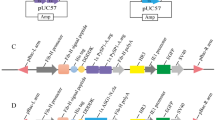Abstract
To obtain transgenic tobacco plants expressing recombinant analogs of spider dragline silk spidroin 1, artificial 1f5 and 1f 9 coding for spidroin 1 analogs were 3"-fused in-frame with the reporter lichenase gene. The Tr2" weak constitutive promoter of Agrobacterium tumefaciens T-DNA and the strong constitutive promoter of the cauliflower mosaic virus 35S RNA gene were used as regulatory elements. The expression cassettes were used to transform agrobacteria and then introduced in tobacco leaf disks. On evidence of Southern hybridization, transgenic plants each carried a single copy of a hybrid gene, which corresponded in size to the constructed one. Zymography and Western blotting revealed full-length hybrid proteins in leaf extracts of transgenic plants. The results testified that plants can maintain and express synthetic genes for spider silks and, consequently, may be used as a convenient producer of recombinant silk analogs.
Similar content being viewed by others
REFERENCES
Hinman M.B., Stauffer S.L., Lewis R.V. 1994. Mechanical and chemical properties of certain spider silks. In: Silk Polymers: Materials Science and Biotechnology. Eds. Kaplan D., Adams W.W., Farmer B., Viney C. Washington: American Chemical Society, pp. 222–233.
Guerrette P.A., Ginzinger D.G., Weber B.H.F., Gosline J.M. 1996. Silk properties determined by gland-specific expression of spider fibroin gene family. Science. 272, 112–115.
Hayashi C.Y., Lewis R.V. 1998. Evidence from flagelli-form silk cDNA for the structural basis of elasticity and modular nature of spider silks. J. Mol. Biol. 275, 773–784.
Gatesy J., Hayashi C., Motriuk D., Woods J., Lewis R. 2001. Extreme diversity, conservation, and convergence of spider silk fibroin sequences. Science. 291, 2603–2605.
Eds. Kaplan D.L., Adams W.W., Viney C., Farmer B.L. Silk Polymers: Materials Science and Biotechnology. 1994. Washington: ACS Books.
Gosline J., Guerette P., Ortlep C., Savage K. 1999. The mechanical design of spider silks: from fibroin sequence to mechanical function. J. Exp. Biol. 302, 3295–3303.
Winkler S., Szela S., Avtges P., ValLuzzi R., Kirschner D.A., Kaplan D. 1999. Designing recombinant spider silk proteins to control assembly. Int. J. Biol. Macromol. 2 4, 265–270.
Fahnestock S. R., Irwin S. L. 1997. Synthetic spider dragline silk proteins and their production in Escherichia coli. Appl. Microbiol. Biotechnol. 47, 23–32.
Fahnestock S. R., Bedzyk L. A. 1997. Production of synthetic spider dragline silk protein in Pichia pastoris. Appl. Microbiol. Biotechnol. 47, 33–39.
Scheller J., Guhrs K.-H., Grosse F., Conrad U. 2001. Production of spider silk proteins in tobacco and potato. Nature Biotechnol. 19, 573–577.
Sambrook J., Fritsch E.F., Maniatis T. 1989. Molecular cloning: a laboratory manual. Cold Spring Harbor NY: Cold Spring Harbor Laboratory Press.
Bogush V.G., Sidoruk K.V., Molchan O.K., Ptitsyn L.R., Al'tman I.B., Kozlov D.G., Efremov B.D., Benevolenskii S.V., Agapov I.I., Mashko S.V., Debabov V.G. 2000. Molecular cloning and expression in yeast of synthetic genes coding for dragline spidroin 1 analogs. Biotekhnologiya. 2, 11–22.
Mysiychuk K.A., Goldenkova I.V., Abdeev R.M., Kobets N.S., Piruzian E.S. 2000. Construction and properties of deletion derivatives of Clostridium thermocellum lichenase and their use to obtain bifunctional hybrid proteins. Biokhimiya. 65, 1659–1665.
Alliotte T., Zhu L.H., Van Montagu M., Inze D. 1988. Plant expression vectors with the origin of replication of the W-type plasmids. Plasmid. 19, 251–254.
Movsesyan N.R., Alizade Kh., Abdeev R.A., Mysiychuk K.A., Popov Yu.G., Piruzian E.S. 2001. Transgenic tobacco plants expressing bacterial genes for thermo-stable glucanases. Genetika. 37, 745–752.
Lazo G.R., Stein P.A., Ludwig R.A. 1991. A DNA transformation-competent Arabidopsis genomic library in Agrobacterium. Biotechnol. 9, 963–967.
Plant genetic transformation and gene expression: A laboratory manual. 1988. Eds. Draper, J., Scott, R., Armitage, P., and Walden, R. Oxford: Blackwell.
van Lijsebettens, Valvekens M. 1987. In: EMBO Practical Course on Plant Molecular Biology. Eds. van Lijsebettens, M., Valvekens D. Gent, Belgium, pp. 15–18.
Deblaere R., Reynaerts A., Hofte H., Hernalsteens J.P., Leemans J., van Montagu M. 1987. Vector for cloning in plant cells. Meth. Enzymol. 153, 277–292.
Wood T.M., Bhat K.M. 1988. Methods for measuring cellulase activities. Meth. Enzymol. 160, 87–112.
Bradford M.M. 1976. A rapid sensitive method for the action of microgram quantities of protein utilizing the principle of protein-dye binding. Analyt. Biochem. 72, 248–254.
Piruzian E.S., Monzavi-Karbassi B., Darbinian N.S., Goldenkova I.V., Kobets N.S., Mochulsky A.V. 1998. The use of a thermoactive β-glucanase gene from Clostridium thermocellum as a reporter gene in plants. Mol. Gen. Genet. 257, 561–567.
Piruzian E.S., Goldenkova I.V., Mysiychuk K.A., Kobets N.S., Arman I.P., Bobrysheva I.V., Chekhuta I.F., Glazkova D. 2002. A reporter system for prokaryotic and eukaryotic cells based on the thermostable lichenase from Clostridium thermocellum. Mol. Genet. Genomics. 266, 778–786.
Goldenkova I.V., Mysiychuk K.A., Piruzian E.S. 2002. A thermostable Clostridium thermocellum lichenase-based reporter system for studying the gene expression regulation in prokaryotic and eukaryotic cells. Mol. Biol. 36, 868–876.
Herbers K., Sonnewald U. 1999. Production of new-modified proteins in transgenic plants. Curr. Opin. Biotechnol. 10, 163–168.
Fiedler U., Conrad U. 1995. High-level production and long-term storage of engineered antibodies in transgenic tobacco seeds. Biotechnol. 13, 1090–1093.
Author information
Authors and Affiliations
Rights and permissions
About this article
Cite this article
Piruzian, E.S., Bogush, V.G., Sidoruk, K.V. et al. Construction of Synthetic Genes for Analogs of Spider Silk Spidroin 1 and Their Expression in Tobacco Plants. Molecular Biology 37, 554–560 (2003). https://doi.org/10.1023/A:1025187311024
Issue Date:
DOI: https://doi.org/10.1023/A:1025187311024




